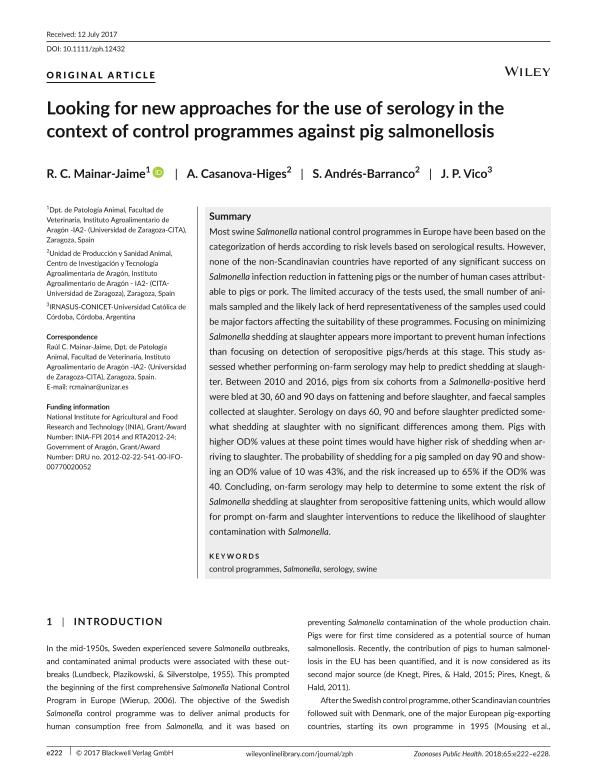Artículo
Looking for new approaches for the use of serology in the context of control programmes against pig salmonellosis
Fecha de publicación:
02/2018
Editorial:
Wiley Blackwell Publishing, Inc
Revista:
Zoonoses and Public Health
ISSN:
1863-1959
Idioma:
Inglés
Tipo de recurso:
Artículo publicado
Clasificación temática:
Resumen
Most swine Salmonella national control programmes in Europe have been based on the categorization of herds according to risk levels based on serological results. However, none of the non-Scandinavian countries have reported of any significant success on Salmonella infection reduction in fattening pigs or the number of human cases attributable to pigs or pork. The limited accuracy of the tests used, the small number of animals sampled and the likely lack of herd representativeness of the samples used could be major factors affecting the suitability of these programmes. Focusing on minimizing Salmonella shedding at slaughter appears more important to prevent human infections than focusing on detection of seropositive pigs/herds at this stage. This study assessed whether performing on-farm serology may help to predict shedding at slaughter. Between 2010 and 2016, pigs from six cohorts from a Salmonella-positive herd were bled at 30, 60 and 90 days on fattening and before slaughter, and faecal samples collected at slaughter. Serology on days 60, 90 and before slaughter predicted somewhat shedding at slaughter with no significant differences among them. Pigs with higher OD% values at these point times would have higher risk of shedding when arriving to slaughter. The probability of shedding for a pig sampled on day 90 and showing an OD% value of 10 was 43%, and the risk increased up to 65% if the OD% was 40. Concluding, on-farm serology may help to determine to some extent the risk of Salmonella shedding at slaughter from seropositive fattening units, which would allow for prompt on-farm and slaughter interventions to reduce the likelihood of slaughter contamination with Salmonella.
Palabras clave:
Control Programmes
,
Salmonella
,
Serology
,
Swine
Archivos asociados
Licencia
Identificadores
Colecciones
Articulos(IRNASUS)
Articulos de INSTITUTO DE INVESTIGACIONES EN RECURSOS NATURALES Y SUSTENTABILIDAD JOSE SANCHEZ LABRADOR S.J.
Articulos de INSTITUTO DE INVESTIGACIONES EN RECURSOS NATURALES Y SUSTENTABILIDAD JOSE SANCHEZ LABRADOR S.J.
Citación
Mainar-Jaime, R.C.; Casanova-Higes, A.; Andrés-Barranco, S.; Vico, Juan Pablo; Looking for new approaches for the use of serology in the context of control programmes against pig salmonellosis; Wiley Blackwell Publishing, Inc; Zoonoses and Public Health; 65; 1; 2-2018; e222-e228
Compartir
Altmétricas




